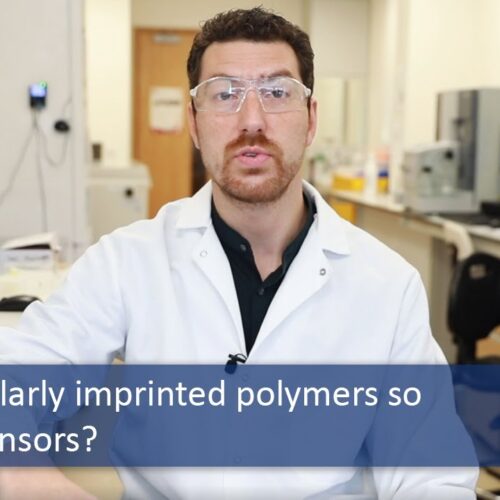Why are molecularly imprinted polymers so well suited to sensors?
The MIP Discovery Video Series gives an introduction to Molecularly Imprinted Polymers, explaining what they are, how they are made and their applications in medical diagnostics and healthcare. In the third instalment of the series, Head of Chemistry, Dr Francesco Canfarotta, takes a look at why molecularly imprinted polymers are so well suited to sensor devices, and shares some performance results of MIP based sensors.

Video Transcript
Hi, welcome to the MIP Discovery video series. I am Francesco Canfarotta, Head of Chemistry at MIP Diagnostics, and in today’s video I am going to be explaining why molecularly imprinted polymers work so well in sensor devices.
If you are not familiar with Molecularly Imprinted Polymers, usually referred to as MIPs, they are synthetic antibodies that are chemically produced in a lab in a completely animal free process.
MIP Diagnostics specialize in a specific type of MIP called nanoMIPs; these are nanoscale molecularly imprinted polymers that have been designed and produced to have a high affinity and specificity to a specific target of interest, ideal for use as the receptor in sensor devices.
Early forms of MIPs for use in sensor devices were first mentioned in research back in 1931, but it has only been in the last decade that research in this field has really accelerated. Today over 30,000 research papers on MIP based sensors have been published, and the technology is now being commercialized across the globe.
So, why are MIPs so well suited to sensor devices?
One of the key advantages that MIPs have over traditional affinity reagents such as antibodies is their stability. Because of their chemical make-up, MIPs are extremely robust and can withstand extreme temperatures, pressures and pH. To demonstrate this, MIP Diagnostics have carried our various experiments, including autoclaving MIPs to 121 degrees Celcius and testing their affinity both pre-and post-autoclave. The results have shown a consistent affinity within experimental error, showing that the high temperature does not impact their structure or performance.
These robust features enable MIP based sensors to be used in various different settings, spanning multiple different industries. One such example is in the oil and gas industry, where sampling sites are often in high temperature or high-pressure locations. Natural biosensor receptors would perish in these types of environments, so samples are traditionally collected and sent for lab-based testing, with results usually in two to three days. MIPs on the other hand cab be used on-site which means results can be acted on almost instantly.
Their robust characteristics also mean MIPs are much simpler to integrate into sensor platforms when compared with natural receptors such as antibodies or nucleic acids. MIPs more easily couple to the surface of an electrode, whereas natural receptors can deform or denature during the coupling process which in turn can lead to gaps in coverage on the sensor.
Another great feature of MIPs that is enabling more sensor applications is that they can be generated to such a wide variety of targets. Traditional receptors, such as antibodies, are difficult to generate to small molecules or toxic substances but, since MIPs are completely synthetic, they do not face these challenges. Types of targets range from small molecules of less than 1nm in size, right through to whole viruses and bacteriophages of more than 400nm.
MIP Diagnostics has worked with several partners to demonstrate the results that can be achieved when using a MIP as the receptor in a sensor device.
Dr Marloes Peeters group at Newcastle University have used their thermal sensor platform to compare the performance of COVID-19 nanoMIPs to monoclonal antibodies. Their results showed that a sensor device using MIPs could achieve a much greater sensitivity, with a Limit of Detection of <5 fg/ml compared to approximately 105 fg/ml when using an antibody.
Dr Balla’s Group at Ulster University has integrated the same COVID-19 nanoMIPs into their localized surface plasmon resonance device. To test specificity of the nanoMIP, multiple variants of SARS-CoV-2 alongside other human coronaviruses were tested, and the device was indeed selective to the SARS-CoV-2 variants only.
Finally, Soterius, an Australian sensor developer has also integrated the COVID-19 nanoMIP into their passive biosensor device, the Soterius Scout, which detects virus particles landing on the sensor surface and communicates this result to a smartphone or a reader. Users swipe the sensor fob on the reader as they enter or exit a hospital, school or workplace and are immediately alerted to the presence of the virus.
As biosensor devices based on molecularly imprinted polymers continue to be developed and commercialised, we are set to see more sensitive and robust devices contributing to advancing healthcare and industrial applications in the years to come.
Thanks for watching this short video. To learn more about the other applications of MIPs remember to check out the rest of the videos in our MIP Discovery series, and please get in touch to discuss your specific projects with our team.

